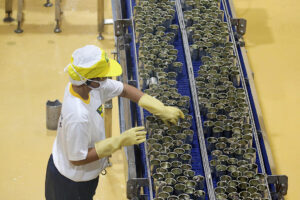THE ECONOMY requires stronger industry spending if gross domestic product (GDP) is to move beyond its current growth track, the Bank of the Philippine Islands (BPI) said.
“Recent growth in the 5-6% range suggests that consumption alone is no longer enough to drive the economy forward. While domestic demand remains robust, the economy doesn’t produce a significant portion of what it consumes, reflecting its weakness in production. The industry sector must take a bigger role in supporting growth,” BPI Lead Economist Emilio S. Neri, Jr. said in a report.
The economy expanded by an annual 5.5% in the second quarter, hitting the lower end of the government’s 5.5-6.5% target for the year.
For the first half, GDP growth averaged 5.4%, against 6.2% a year earlier.
Household final consumption, which accounts for over 70% of the economy, grew 5.5% in the three months to June, exceeding the 4.8% posted in the second quarter of 2024.
Mr. Neri noted household consumption still has not recovered to pre-pandemic levels.
“It is possible that recent weakness in consumption data partly reflects the challenges in capturing purchases made through e-commerce. The growing access to foreign goods that can be shipped directly to consumers has made tracking certain transactions more difficult, as some low value items may be exempt from monitoring,” he added.
Mr. Neri said GDP growth could remain in the 5-6% range in the coming years if the government is unable to address the structural challenges holding back construction, manufacturing, and investment.
“The economy must shift from being consumption-driven to production-driven, with policies that promote long-term investment and industrial development,” he said.
Construction growth was also weak in the second quarter at 2%, well below the pre-pandemic average of 10.8%, due to the election spending ban. Private-sector construction grew in the double digits but remained below pre-pandemic levels.
He added that real estate developers have taken a cautious approach to new projects due to weak demand in the mid-tier markets.
“Hybrid work arrangements have reduced the appetite for residential units near business districts and have contributed to elevated office vacancy rates,” Mr. Neri said.
While public housing demand remains high, household income needs to catch up with faster-rising property prices for the construction recovery to pick up.
Manufacturing growth likewise remained below pre-pandemic levels at 2.7% from the average of 5.8% before the pandemic as key industries such as food, chemicals, and electronics struggled due to rising input costs and global supply chain disruptions.
Weaker consumption growth has also affected demand for manufactured goods.
“With capital-intensive industries like construction and manufacturing underperforming, investment spending has been sluggish as well. Sustained public-sector spending on infrastructure has not been enough to offset the weakness in private-sector capital expenditures,” Mr. Neri said.
He added that while the economy shifts to more industry spending, inflation must remain low and stable to continue supporting consumption.
The services sector, especially in outsourcing and tourism, also needs to remain competitive during the shift towards more industrial activity.
“The ideal outcome is for the economy to have several drivers of growth, with consumption serving as the foundation rather than an end in itself. Sustaining growth above 6% will be difficult if the industry sector fails to improve and if the services sector loses its competitive edge,” Mr. Neri said. — Aaron Michael C. Sy

